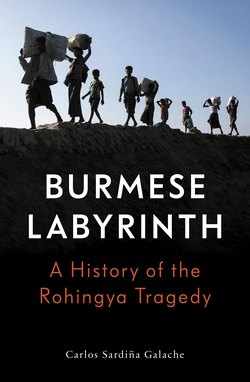Читать книгу The Burmese Labyrinth - Carlos Sardiña Galache - Страница 7
На сайте Литреса книга снята с продажи.
ОглавлениеNote on Burmese Terms
In 1989, the military junta ruling Burma changed the official name of the country, and those of several regions and cities, returning them to their old names in the literary Burmese language. By the Adaptation of Expressions Law, both ‘Burma’ and ‘Burmese’ were changed to ‘Myanmar’. The change only affected languages other than Burmese, as ‘Myanmar’ had been the official name of the country in the language of the Burman majority. One of the explanations was that ‘Burma’ had been imposed by the British colonial power. But that was not entirely true, since ‘Burma’ is just a transliteration of the less formal word for the country in Burmese, and not a new name imposed by the colonial overlord – as is the case, for example, of ‘the Philippines’, a completely new name coined by the Spaniards in honour of the conquering King Philip II. In reality, ‘Burma’ and ‘Myanmar’ mean exactly the same, and asking speakers of other languages to use one instead of the other is the equivalent of asking non-German-speakers to use ‘Deutschland’ instead of ‘Germany’.
The United Nations and some governments accepted the change, but many other countries and the international media continued to call the country ‘Burma’. There was a time when choosing one term or the other had political connotations, as Aung San Suu Kyi had opposed the change. But ‘Myanmar’ has become internationally accepted since the transition in 2012. Throughout this book, I will use the name ‘Burma’, except when quoting other writers or public documents where ‘Myanmar’ is used. This is both a matter of personal preference and a function of the fact that, for most of the long period covered in the book, the country was known as Burma.
The name of the state of ‘Arakan’ was changed to ‘Rakhine’ in 1983, probably to please Rakhine nationalists. Throughout this book, I use ‘Arakan’ to refer to the state, and ‘Rakhine’ to refer to the majority ethnic group in Arakan, as I understand Arakan, the place, to have more inclusive connotations.
The majority group in the country is called ‘Bamar’ or ‘Burman’. I have opted for ‘Burman’ because it is consistent with the use of Burma rather than Myanmar. ‘Burmese’ refers to any citizen of the country, regardless of ethnicity. But the Burmese language is that spoken by the Burman majority. In colonial times, it was the other way round: ‘Burmese’ was used for the ethnic group ‘Burman’. I have noted this when necessary. It is also worth pointing out that many members of the ethnic minorities use ‘Burmese’ when referring to the ‘Burmans’. This shows the extent of confusion about national identity and the failure to create a multi-ethnic Burmese nationalism.
In some press reports and books that adopt the ‘Myanmar’ terminology, some names are different to those used in this book. I show here the equivalent variants of the most important names for states and cities used throughout the book (others, such Kachin, are the same in both terminologies):
| Burma (country)/Burmese (citizens of, language) | Myanmar |
| Burman (ethnic group) | Bamar |
| Rangoon (city) | Yangon |
| Arakan (state)/Arakanese (ethnic group) | Rakhine |
| Irrawaddy (river and division) | Ayeyarwady |
| Karen (both state and ethnic group) | Kayin |
| Karenni (both state and ethnic group) | Kayah |
| Moulmein (city) | Mawlamyine |
| Tenasserim (division) | Tanintharyi |
Members of ethnic groups like the Burman, Mon or Rakhine, do not have surnames, so their names are repeated in full every time they are mentioned – with the exception of Aung San Suu Kyi, who is often called simply ‘Suu Kyi’. Other ethnic groups like the Kachin or Chin names do often include family or clan names, and sometimes individuals may be referred to only by their surnames.
The Burmese often use honorifics determined by the relative age or social status of the person addressing them. For instance, to refer to a mature woman, or one holding a senior position, the speaker would add ‘Daw’ (as in ‘Daw Aung San Suu Kyi’, used often in Burmese media). For senior men, either by age or position, ‘U’ is commonly added (as in ‘U Nu’). Further examples of these honorifics include the following:
| Daw | for mature women and/or women occupying senior positions (roughly equivalent to ‘aunt’ or ‘Ms’) |
| Ma | for young women or women of roughly the same age as the speaker (roughly equivalent to ‘sister’ or ‘Ms’) |
| U | for mature men and/or men occupying senior positions (roughly equivalent to ‘uncle’ or ‘Mr’) |
| Ko | for young men or men of roughly similar age to the speaker (roughly equivalent to ‘brother’) |
| Maung | for younger men, often part of the name |
| Saya | for teachers or older men with special status |
| Ashin | for monks |
| Sayadaw | for senior monks |
| Bo | for military commanders |
| Bogyoke | for military generals |
| Thakin | ‘master’, used by the nationalists in the 1930s and 1940s to indicate that they were the masters of their own country |
I have not used these honorifics except in cases when they are so closely associated with the name of the person that they are rarely omitted (as in the case of the first prime minister of independent Burma, U Nu), or when quoting others using them.
